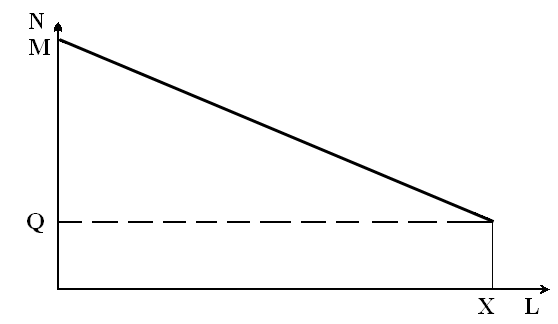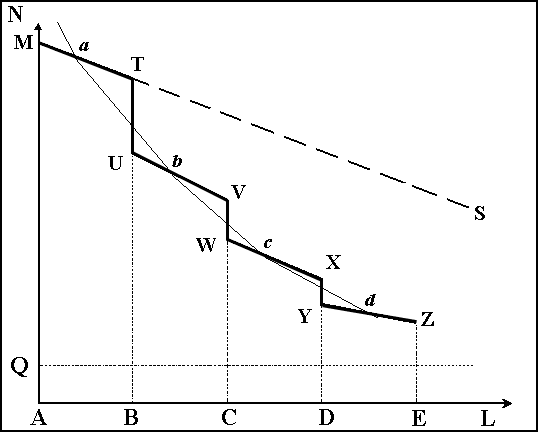Main postulates
The study of prehistoric ethnogenic processes was performed in accordance with some postulates which I set up arbitrarily as assumptions in solving a specific task taken by myself.
The first postulate – Language continuum.
Guided by the conclusions of certain scholars of the past (PAUL H. 1960, 58.) we can assume that when some people settle on a vast and plain territory with no special geographical obstacles during the process of its cultural formation, at some point the increase of its vocabulary connected with these advances will eventuate in the development of isolated dialects from the original unitary language of this people. And these dialects will produce such language continuum that will result in the differences between isolated dialects that increase monotonously and proportional to the distance separating certain ethnical groups as speakers of these dialects.
Almost ideal conditions for such language development, according to the described scenario, existed in plain Australia which is not crossed by big rivers. A Russian scholar V.A. Shnirelman describes the language situation in Australia:
“Language continuum was characteristic for Australian aborigines, i.e. tongues or dialects of adjacent groups demonstrated large similarity and their speakers understood each other well, whereas mutual intelligibility gradually disappeared with the distance between the groups” (SHNIRELMAN V.A.,1982, 88).

If we graphically reflect the described language situation in our hypothetical territory of Australian type, it has the appearance of the line MS on figure 1.
Fig.1 Distribution of the number of common words between the dialects on the space without geographical boundaries
N is the number of mutual words between dialects. L is the distance between the habitats. M is the total number of words in one of the dialects. Q is the number of first-level words for all dialects. X – the distance at which the community of newly formed words disappears.
The second postulate – Chronological stratification of the lexical stock.
If primary people had their language with the total number of lexical items – Q from the outset of its settlement at certain territory, the new dialects continuum could develop in two ways:
1. by the production and interchange of new words among the dialects with the increase of Q in the language,
2. by decrease of initial total Q in each dialect. But both processes develop at different speeds. The process of the production and interchange of new words develops quicker than the loss of some words in the initial total vocabulary. As the result, the entire vocabulary stock of each dialect can be divided into two layers – words derived from the parent language which we shall later name as the words of the first level and new words which we shall name as the words of the second level.
It is important to clarify this above-postulated correlation of the mutual words volume and the distance between the dialects, as, in fact, it is influenced only by the words of the second level, because the words of the first level remain in approximately equal quantity at each time point in all the dialects.
The third postulate – There is an inverse relationship between the number of common features in a pair of languages and the distance between the areas in which these languages are formed..
If the settlement area of an ethnic group – the speakers of an individual language has geographical barriers which prevent their equable movement and communication and causes the formation of more or less permanent settlement areas of these groups, then not a continuum of dialects but a certain number of discrete dialects arise within these areas, boundaries between them are these geographical barriers. The originality of the geographical features of such areas results that the isolation of the primary ethnical foci occurring more than once, so they can be called ethno-generating areas. The size of these areas, which on linguistic and cultural innovations emerge and spread, can not be too large, otherwise within its boundaries may occur a continuum of language that will not conduce to the consolidation of the population into a single ethnic unit.
The consequence of the existence of natural boundaries is that the language continuum on the common settlement territory is violated, and the function N=(M – Q) – kL has a discontinuity at the point of intersection of the boundary. Simply put, the number of common languages features (among them words) between different groups within the territory decreases monotonically in proportion to the distance between their settlements (but at a slower rate than in the type of Australia, as within the range of the population now has closer contacts), as the number of common features decreases abruptly at the frontier. We can assume that a certain more or less constant percentage of the common words of the second level is being lost at every crossing of the boundary. In this case, the distribution of the number of common words, depending on the distance will be like that shown in Figure 2 by the broken line MTUVWXYZ.

Fig. 2. Distribution of the number of mutual lexical items between dialects in areas, separated by ethnical boundaries.
N – the number of mutual lexical items in dialects; L – the distance between the habitats (areas); Q – the number of first level lexical items, being the same for all dialects; M – the total number of words in an isolated dialect; AB, BC, CD, DE, – areas of isolated dialects.
This distribution has too complex mathematical expression. But if we agree to consider newly developed isolated dialects within areas AB, BC, CD, DE as individual language units, we can consider the distance between them to be equal to the distance between their area centres. Thus, connecting the centres of segments MT, UV, WX, YZ, we obtain the distribution of mutual lexical items (words, for simplicity) in dialects as the line abcd. And if we move the origin of the co-ordinate to the point Q, we’ll see that the shape of this line in its central part will be close to hyperbola; therefore it can be described with the function of inverse proportionality y=k/x. In this case, the correlation of the number of words of the second level in the dialects and the distance between the centres of habitats can be approximately described with the formula:
M – Q = K/L,
where K is the coefficient of proportionality.
Certain inaccessibility of habitats of isolated dialect speakers will eventuate in such difference between these dialects that the parent unitary language will split into new distinct languages which we shall call further the languages of the second level. These languages can be derived again and produce new languages of the third level if the second level language speakers migrate to a new large territory. The combined complex of words of the first and second levels will remain in the languages of the third level. This process can continue further on producing the family tree of monophyletic languages.
As the result of this process a great deal of the word complex of low levels was conserved in the languages of the higher levels, but only words of the highest level will be subordinate to the law of inverse proportionality, i. e. when the number of mutual words of this level is depended on the distance between the ethno-producing areas of languages. Thus when we analyse languages of the higher levels, we have to remove all the words of lower levels from the study, as a rule, such words are common for all analysed languages, and it considerably facilitates their exclusion.
This idea of the origin of languages was expressed more than a hundred years ago by the Swedish philologist and religious figure Andreas Jäger (1660-1730):
An ancient language, once spoken in the distant past in the area of the Caucasus mountains and spreading by waves of migration throughout Europe and Asia, had itself ceased to be spoken and had left no linguistic monuments behind, but had as a "mother” generated a host of “daughter languages,” many of which in turn had become "mothers” to further “daughters”. For a language tends to develop dialects, and these dialects in the course of time become independent, mutually unintelligible languages (quoted after по Goldsmith John A. and Laks Bernard. 2019, 79).
The fourth postulate – The graphic model of mutual arrangement of cognate languages of the same level which reflects the disposition of habitats of its speakers can be built by means of the surviving vocabulary which can be found in available dictionaries.
The performed theoretical calculations permit to state that the internal structure of vocabulary material of cognate languages can not be impaired, even if its vocabulary has lost some part of items and contains desultory loan words from the various unrelated languages encountered in different regions and at different time. (STETSYUK VALENTYN, 1998, 18-20)
Generally speaking, we can say that you really have to work with a fuzzy set of elements, each of which only to a certain extent belongs to a certain imaginary set that well corresponds to the law of inverse proportionality. It is impossible to accurately determine the measure of membership, but the construction of a graphical model should indicate that this measure in most cases is sufficient.

